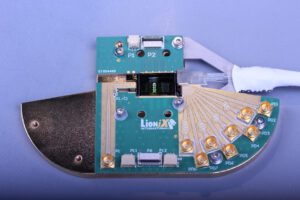Optical beamforming success heralds responsive broadband networks
Broadband mobile networks that respond to localized demand are a step closer thanks to optical beamforming technology reported by LioniX International and partners this month.
For mobile network operators to keep up with increasing demand for bandwidth, upgrades must not only increase antenna bandwidth but must enable infrastructure to respond to localized demand. The innovations reported from the three-year European project, blueSPACE, address these requirements using photonic signal processing. In particular, through an integrated optical beamformer used to “steer” broadband signals.
An integrated optical beamforming network (OBFN), similar to the module developed in the BlueSPACE project, showing hybrid integrated photonic integrated circuits and radio frequency (RF) electronics.
By employing this so-called beam-forming technology, a broadband signal can be focused by remote means on areas of high network demand. Not only does such beam steering radically increase network capacity, but it can be achieved with no moving parts, making for more robust and flexible infrastructure.
To develop the technology using photonics, LioniX International developed novel hybrid integration and packaging approaches. This approach combined two different photonic integrated circuit (PIC) technologies – low-loss silicon nitride and active indium phosphide. The result is high performance, low power optical beamforming modules.
The blueSPACE report published this month details the potential applications of the wider group of integrated microwave photonics technologies in new markets such as smart cities, e-health, intelligent transport, education, entertainment and media.


